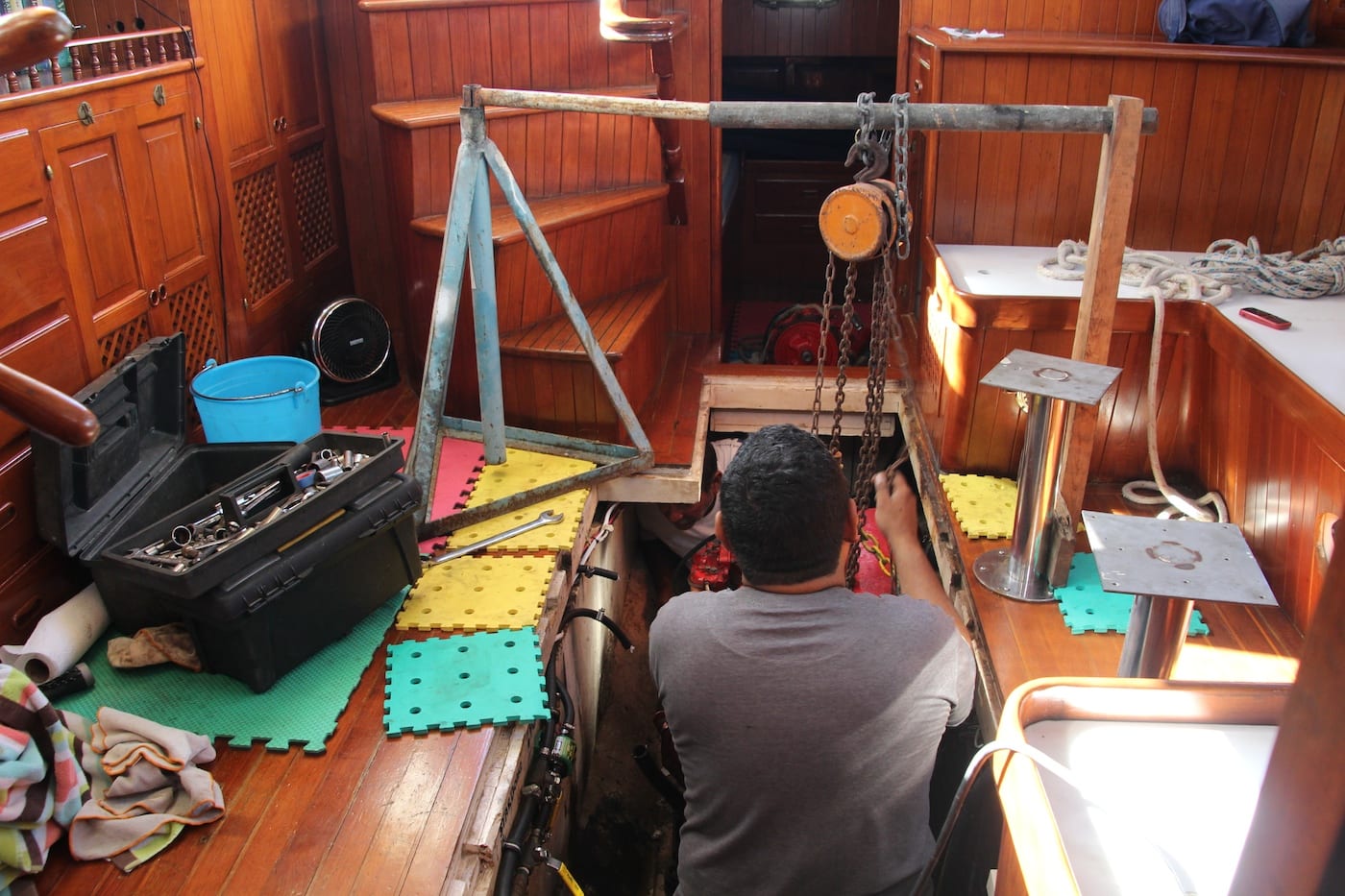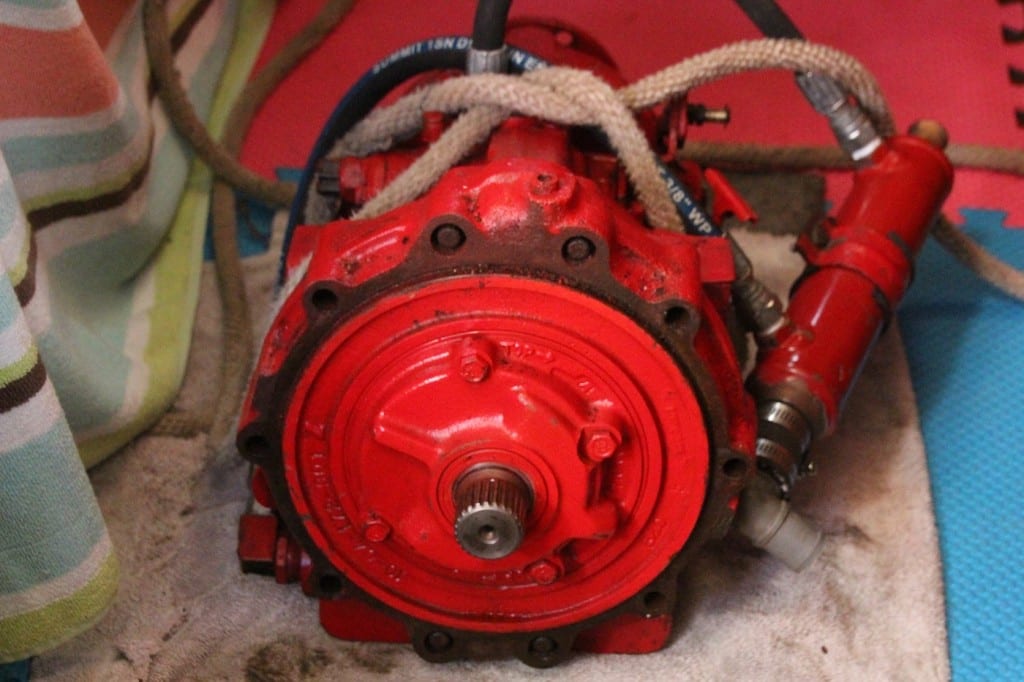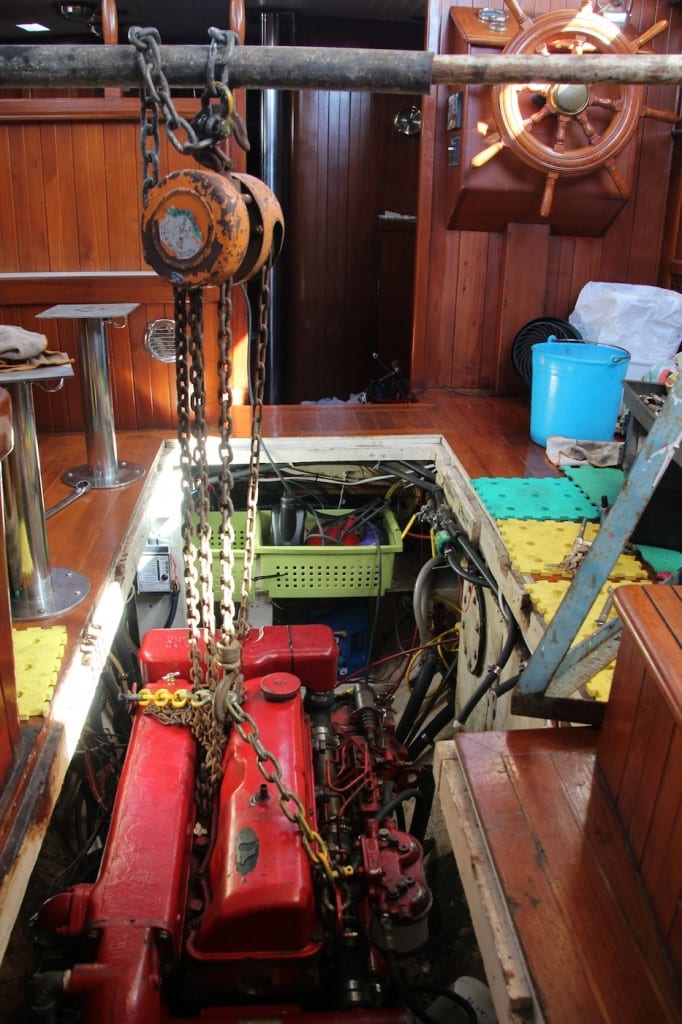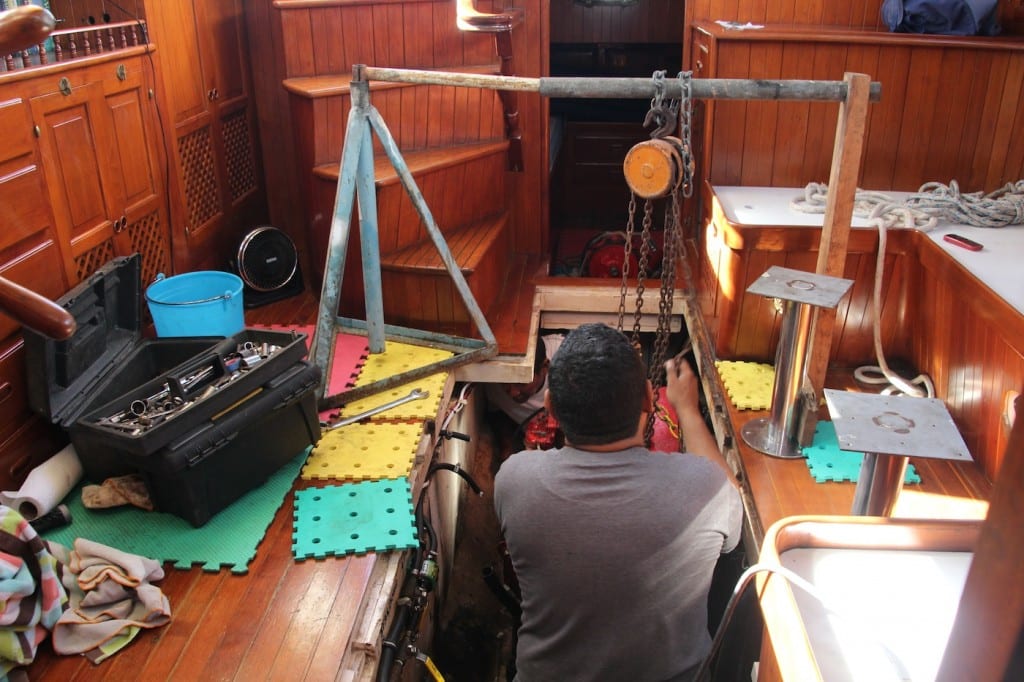Yesterday, with the help of a mechanic and his partner, we tore apart the engine. This time instead of ripping off the head we dug into the belly. We wanted to get the oil pan off so we could have a look at the underside of the valves and see if we could isolate which one was leaking (coolant has been disappearing all by itself overnight and reappearing in the oil pan).
Unfortunately getting the oil pan off of this engine is not as straightforward as it sounds. It’s sort of integrated with the transmission which requires actually first removing the transmission completely. Then, because of the design of the boat the engine has to be lifted a few inches to actually be able to pull the pan out from underneath.
Getting all of this done also required the removal of the fuel filter, the raw water filter, the refrigerator compressor, and a water hose or two. On the plus side, removing all of this stuff made cleaning the engine compartment much easier than normal.
So this morning we had the oil pan off and we filled up the coolant for our drip test. Keep in mind that gallons of coolant had leaked into the oil pan up until last week when I stopped filling it up. So we filled it and waited. And waited. And went to lunch. And waited. And not a single drop disappeared. Not even one drop down a cylinder to give us some idea of what the problem was.
We then hooked up an air compressor and filled the system with some pressure. Surely this would push the coolant/water through wherever it had been leaking a few days back. Nope. Not a drop. We turned the motor, pumping the pistons up and down trying to make sure the piston wasn’t just blocking the leak. Nothing.
Thing is, this should be good news. I mean, if water is flowing through a cylinder we’ve got a problem. But at this point I’d be happy to find a problem so that we could begin solving it.
I should mention here that our cylinders are sleeved. I wasn’t aware of this, or really what the significance of this was until today. But now I know. So what we were expecting to find today was maybe a cracked or worn sleeve, or worst case a hole in the block behind one of the sleeves. Because we didn’t find a leak we are pretty confident now that those things aren’t the problem. But not 100% sure. The #1 cylinder showed some “oxidation” which indicated that some water was getting in there and burning up while the engine was running. So that may very well still be the problem, but today we weren’t able to answer that definitively—which was the entire purpose of tearing the engine apart.
Tonight the engine is sitting with air pressure still on the system. If the coolant is still full in the morning we’re going to have to begin the search anew. Probably by tearing off the head again to search for problems from the top. If we don’t find anything obvious I’ll probably end up replacing that #1 sleeve, and throwing all new gaskets on again. Then put everything back together and pray.
Which reminds me, I’ve got to find a religion.
Also, when removing the transmission we discovered that the damper plate was shot. Good a time as any to find that. The manual said it should have about a 2,500 hour lifespan. This one has about 3,000 on it.





31 Comments on “The Leak Hunt”
Some help with your religion quest. Sorry can’t help with the engine…
“A Flowchart to Determine What Religion You Should Follow”
http://m.quickmeme.com/p/3vp4wf
This is a riot
Hysterical!!!
That is pretty good. 🙂 Turns out I’ve already got the right one/lack of one.
I wonder about the head gasket since it took a 1/2 turn on the head bolts to re-torque them. Diesels have such high compression that the re-torqueing is even more critical. Although why it stopped leaking is certainly mysterious. Good luck finding the problem – I look forward to hearing what it is.
Thanks for a great blog!
I’m admittedly no mechanic. I have no patience for this crap, but have been lucky to have friends who need a project to get through the day. But I have had a feeling you had a small hole in the block somewhere, for which I would think a new short block would be the solution. A thought to find your leak is to put dye in the coolant, run the engine and look for the leak. Best of luck. This sort of issue is a muddy pain in the ass.
This might be a good time to consider an electric propulsion system for Bumfuzzle. No more oily bilges and the cooling,exhaust and lubrication plumbing systems would make a very satisfying pile on the dock.
I too was thinking that, but currently if the engine can be fixed, then it should be. You are talking about a major investment that will come close to 25% of the worth of the boat. I have been looking at re-powering a smaller hull and the prices are in line with a new diesel. Pat freely admits he is not a sailors sailor, he rigs out his iron sail frequently. So he will be looking at a new gen-set as well. And the best gen-set for this type of application is an on-demand DC-DC generator. And those are rather spendy. So he will still need tanks for diesel, just not quite as much, and room for his new battery bank, which is a bit larger that what is currently on board now. So if the engine can be fixed, it will be less expensive than re-powering.
You’re a nice guy Pat and very creative, but your approach to the engine is crazy. Engines are like a football team or a musical chorus. In an experienced team they work well together because they all know each others moves.
Then one gets replaced with a new guy who doesn’t know the team moves and he messes up the routines, and pretty soon the whole thing falls apart.
You’ve got the engine pretty much out now, pull it out and get the mechanics to rebuild it in their workshop. Its not such a big deal, they do it all the time, and you will get an engine that will run for another 2000-3000 hours.
Keep going the way you are and you will forever be head down bum up working on the mongrel.
All the best
+1 to the rebuild idea. At 3000 hours (or more?) it seems a good investment.
Good luck!
Didn’t ypu put a tin of bars leaks in the system at some point? All that goop is probably still in there somewhere, along with everything else that accumulates in engine blocks, blocking up whatever hole is causing the leak.
You probably need to get the engine hot to soften everything up before the leak will start again.
And another thing, I never hear you talk about engine anodes, but they should be there somewhere and need regular replacement. They do the same thing anodes on your hull do – stop electrolosis.
this post reminds me about a question I have about your book. When you began your sailing adventure in the catamaran, you were also losing coolant. But, I don’t recall you ever telling us where it was going and how you fixed it. Do you remember?
I mentioned in an earlier comment that I had a case of disappearing coolant. After months of searching, I finally discovered it was a small leak from the bleeder valve on my water heater. It dripped into the rudder post area and evaporated before draining to the bilge. I hope you discover your leak soon!
Pat,
I don’t know your motor so here goes.
After taking apart bolt on stuff you don’t have a leak.
No indication of water in the cylinders even with an air pressure test on the cooling system.
Sounds like the issue is with a bolt on “thing”.
Draw a diagram of the cooling system, were does the water flow from/ to. See if you can start bolting things on and bypassing other bolt on items to eliminate each one and continue a pressure test. With that much flowing into the pan it has to be a fairly large leak.
Interesting post for someone like me who is about to buy a similar boat… I need to have a serious look at it’s motor, which seems identical to yours. Good that you’re able to put it apart at all, even with the improvised jig.
I must say that I agree with a previous comment: if you can afford it, this might be the right moment to refurbish your motor. These kind of leaks etc. don’t appear on their own, they might be indications of a general wearing out of your cooling system and your motor in general. A lack of maintenance by previous owners builds up… it’s rarely just one thing that fails, you fall from one gap into the other.
This is now reading like a mystery novel. I eagerly await the next chapter.
Ha, you say. How dare someone find entertainment from the pain and suffering endured.
I assure you I am empathetic to your engine woes but, intrigued nonetheless. Perhaps the best way to describe reading this: it is like a bad movie. I hate to watch but I really need to see how it ends.
Mark and Cindy
While I also empathize with the frustration Pat must feel, I think it would be doing a great injustice to the truly unfortunate in the world for us to catagorize having engine trouble while living on a sailboat in Mexico after having retired in your 20’s as “pain and suffering.” Let’s keep some perspective here. I only know Pat from his blog, but I think he well realizes where this little diversion fits into the big scheme of things.
“…doing a great injustice to the truly unfortunate in the world…” – Life is all about the choices you make.
Owning a boat and keeping it seaworthy for a family is a full time job. I would not call this retirement by any means. It is darn hard work and requires skill most people cannot possibly imagine.
Mark and Cindy
Pat has well documented, on this very blog no less, his grueling schedule of labor and maintenance to keep his boat going and has preached the gospel of the amount of preparation, and the skills you should acquire before you set foot on a boat.
I assume your being sarcastic since anyone that has followed Bumfuzzle knows that just the opposite is true. Pat’s gospel has always been that sailing is easy, almost anyone can do it with virtually no preparation, and that cruisers exaggerate the amount of skill and preparation necessary, as well as the danger involved. I’m not saying I totally agree, but that has been a constant theme of Pat’s blog since day one. It’s also a big part of what makes this blog worth reading.
Putting things in perspective is good, but…. if you truly do that then there is pretty much no reason to “have” any problems (unless you are at the moment being crushed to death or etc.), and that is not only against human nature, but… .would make a boring blog. I’m not explaining myself very well, but it’s kind of like…. yes, your broken leg is more serious, but my paper cut still stings!
I’m enjoying following the mystery, and in a certain commiserating way I enjoy Pat’s frustration with the engine (because…. I can relate); but I also know that he has a pretty good perspective on life, and knows where he has it good. But I hope he doesn’t stop being human/frustrated/etc. when a bedeviling problem crops up.
One of my first cars had a similar issue, was a big block Camero, anyway it was eventually found that while installing the new head gasket it got slightly crushed in one tiny area allowing water into the cylinder. So I am watching this from the stand point of Pat’s frustration. I too stood impotently in front of an engine that should work, we did everything the right way, there is no reason it shouldn’t work, why doesn’t it work! Did that fix it? NO! this? NO! Darn! So what’s wrong?
Wow, that’s a real mystery. And more fun to think about than my office job. It’s not a bolt-on as some have suggested since the only bolt on that could let coolant enter the oil is the manifold, and you were losing coolant into the oil even with the manifold disconnected. So that leaves you with a bad head, bad head gasket, or cracked block. I would have suggested that its a temperature dependent crack, but from your previous posts it sounds like you were losing coolant even when the engine was stone cold, so you can’t blame it on a crack that is open when the engine is warm but closes up when it cools down, which is not uncommon. The transient leak mystery may have something to do with the position of the valves. If it’s a top end leak it might require that one particular valve is open to let the coolant into the cylinder. I know you said that you turned the engine over, but if it didn’t stop in just the right position the offending valve might be closed and not allowing the coolant into the cylinder.
Interesting development, no leaks now? Unfortunately, it looks like you hane done just about all you can with the engine in the boat?
The picture of the hoist setup makes my palms sweat. Unless the engine is blocked up, tread lightly with putting your hands under it.
Best of luck, keep us posted.
Paul T
On another note, I thought I would share a recipe that only a true empanada Minnesotan would like: White Castle Empanadas
http://www.whitecastle.com/food/recipes/view/330-white-castle-empanadas
2013 Cookoff Winner
10 White Castle Sliders (chopped)
1 Egg
1 Tablespoon water
1 cup shredded sharp cheddar
1/2 package softened Philly Cream Cheese
1 chopped & seeded jalapeno
1/2 chopped red bell pepper
1 teaspoon ground cumin
1/2 teaspoon course kosher salt
1/2 teaspoon pepper
1/2 Teaspoon chili powder
1 package refrigerated pie crust
1. First use the water and egg to make a egg wash then set aside.
2. Second mix the coarse kosher salt and chili powder and set aside.
3. Roll out your pie crusts and use a 3-4 inch cookie cutter to make your empanada rounds.
4. Put on a lightly greased baking sheet and set aside (start with about a dozen or so, you can always make more if needed).
5. Mix the remaining ingredients well to make the empanada filling. Then place 1-2 tablespoons of filling in the center of each round, folding over and crimping the edges together with a fork to close the empanada.
6. Brush the tops with the egg wash and then dust the tops with the chili powder/kosher salt mixture.
7. Bake @ 400 degrees for 12-15 minutes until tops are golden brown. Serve as they are or with you favorite dipping sauce (I prefer a chimichurri).
Submitted by Coltfan13 of Indianapolis, IN
Sounds better than boat engine repair.
Seriously Pat you are going about this engine repair the wrong way. You have been feeling uninspired right? Its your psyche trying to tell you something you are to stubborn to hear.
Engineering is very black and white, there is no grey. Its got to be exactly right. Something nearly right is the same as something completely wrong.
Let the experts fix your motor, and while they are at it get them to make up a bracket for your new engine driven water maker (I guess that is what you have). Its another thing that must be exactly right, or you will be continually throwing and breaking drive belts. I expect the total cost will be less than what that water maker cost you.
Get on with what you are good at – being an adventurer and a great parent.
Stupid engine……
Tend to agree with Jesse. If that much coolant is being lost and it ended up an a cylinder(s)you probably couldn’t turn it over with the starter. If a small amount got into the cylinders, it would probably produce massive amounts of white smoke at start up
Possibly, coolant is entering an internal oil gallery through a break in the head or block? However, if the leak was big enough oil, under pressure, oil might be forced into the coolant passages? In any event, unlike a gasket failure, this kind of leak may be impossible to see.
If your coolant system is holding pressure, perhaps some of the Bars Leak stuff floated around and lodged in a hole or crack? If the water pump is mounted into the block a bad seal or crack in the casting may leak into the pan.
Not knowing what kind of machine shop services are available near you, perhaps something like this is worth considering?
http://www.bomacmarine.com/
Paul T
from a mechanic who rebuilt diesel engines for many years and saw this problem many times 9 times out of 10 it would be a leaking oil cooler or etched liners around the o rings witch seal the water jackets to keep the water from leaking into the oil
i am retired in la cruz if you ever get here maybe i can help you out good luck
stan
Except our oil cooler is raw water cooled only, so that can’t be it. A leaking oil cooler can not possibly have anything to do with the coolant disappearing into the oil pan. Additionally, it was tested.
Also, as I’ve discovered since this last post, this engine does NOT have water jackets. The manual shows them, but this engine doesn’t have them.
So all the easy solutions are gone unfortunately.
May I, respectfully, suggest Deism for your choice of Religion?
Deists don’t believe in miracles, and goddammit I need me a miracle right about now. 🙂